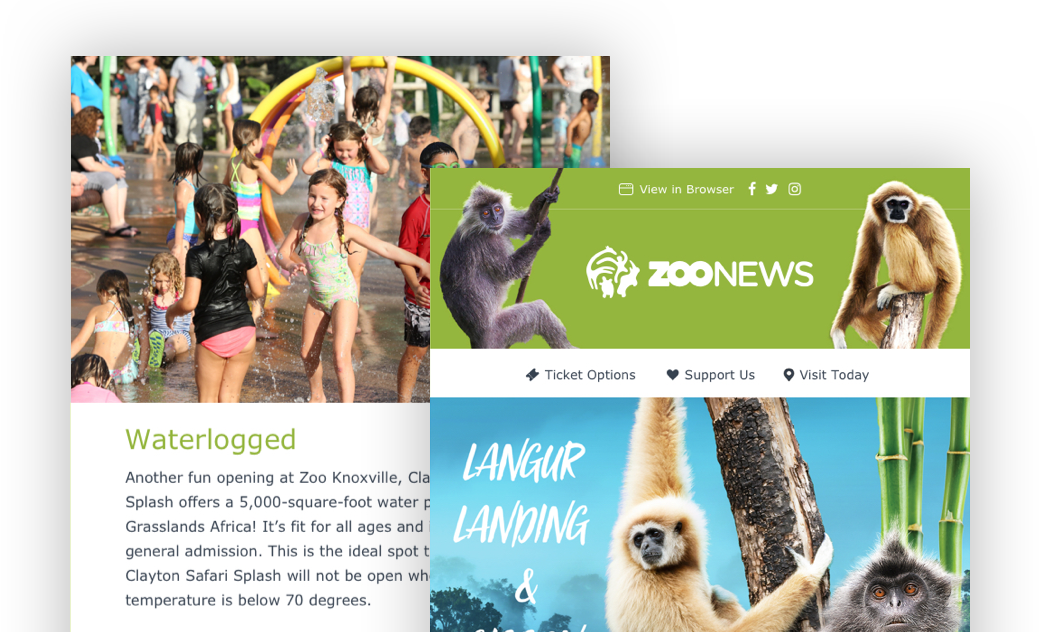Nearly 100 years after Knoxvillians began talking about and raising funds for a Zoo, our zoological and botanical gardens are more vibrant than ever.
Knoxville’s first zoo began in an unlikely way with a newspaper’s 1923 initiative to start a park for poor children, boosted by a Birthday Fund, collected by children, based on their ages. But progress was slow. In 1935, thanks to the city of Knoxville and the New Deal, including the Works Progress Administration and the Tennessee Valley Authority, a four-acre plot was established on a little-used hillside in Chilhowee Park. The Birthday Park, as it was known, included a stone shelter, a small playground and a wading pool. There was talk of starting a zoo at that time, but no funding for one. Neglected and vandalized, the park was closed in 1946.
After a 1948 initiative by the News Sentinel to relaunch the Birthday Park Zoo, using a little money left over from the 1923 fund, the city took the lead in 1951 and renamed it the Municipal Zoo.
The zoo’s first attraction was an alligator named Al, the former pet of the Hauk family of East Fifth Avenue, who had acquired the reptile on a Florida vacation when it was only six inches long. When Al came to the Knoxville zoo, he was six feet long. About 4,000 people came to see Al his first day.
In 1963, the Ringling Brothers Barnum & Bailey Circus had a particularly troublesome African elephant named Louie, or Old Diamond, and donated the animal to the Municipal Zoo, which turned out to be unprepared for taking care of a seven-ton bull elephant. Old Diamond tore up his early enclosures.
Although the elephant raised interest in the zoo for a while, conditions deteriorated. In 1966, the Metropolitan Planning Commission announced plans for an expanded, modern zoo. However, funds were lacking, and by 1970, the old Municipal Zoo seemed to be coming apart. The now-defunct newspaper the Knoxville Journal launched an effort to “Save Old Diamond.”
Guy Lincoln Smith III (1922-1987), the son of the Knoxville Journal’s editor, was a successful television executive. As the old Municipal Zoo seemed to be dissolving, Smith and his wife, Patty, bought a lion cub named Joshua and took care of it until they could raise money to build a proper facility for the rapidly growing lion to live in. About the same time, Dr. Bill Patterson led the founding of the Appalachian Zoological Society, to oversee an educational zoo. The modern Knoxville Zoo was born in 1971.
The zoo successfully mated their most famous resident, Old Diamond, the main attraction at the old Municipal Zoo, with Toto, a younger female. In 1978, their daughter, Little Diamond, became the first African elephant born in the Western Hemisphere. Because African elephants are endangered in their original habitat, it was hailed as an important achievement, not just for the Knoxville Zoo, but for the elephant world. Only two months after Little Diamond’s birth, Old Diamond became father of the second African elephant ever born in America, when Hillary was born to another elephant mother, Sapphire.
Today, Knoxville Zoo is accredited by the national Association of Zoos and Aquariums (AZA) and has a few distinctions not shared by other zoos. More red pandas have been born in Knoxville than any other zoo in the world. Since the birth of Little Diamond, Knoxville Zoo has gone on to other firsts, including being the first zoo in the world to hatch critically endangered northern spider tortoises. Knoxville was also the first zoo in the world to successfully breed the second generation of captive-born Arakan forest turtles and common spider tortoises, an important contribution in the science of conservation.
Credit: The Knoxville History Project’s history page in the Knoxville Mercury

